Financial Decision Making (BUSM4308) - Merger Analysis Report
VerifiedAdded on 2023/01/13
|8
|1477
|79
Report
AI Summary
This report provides a comprehensive analysis of the Royal Dutch Shell merger, examining the motives behind the merger, which aimed to establish a leading position in the oil and gas industry. The report explores the funding sources utilized, including stock exchange and debt financing, and their impact on capital structure. It details share price movements pre and post-merger, linking them to factors such as profitability and resource availability. A comparative analysis of the company's share price within its sector and against the FTSE is presented graphically and discussed. The financial performance of the newly formed corporation is evaluated through ratio analysis, highlighting improvements in profitability and liquidity. The report identifies winners and losers of the merger, and discusses factors that contributed to its success, including due diligence, communication, synergy realization, and organizational fit. The analysis includes references to relevant academic sources and journals.
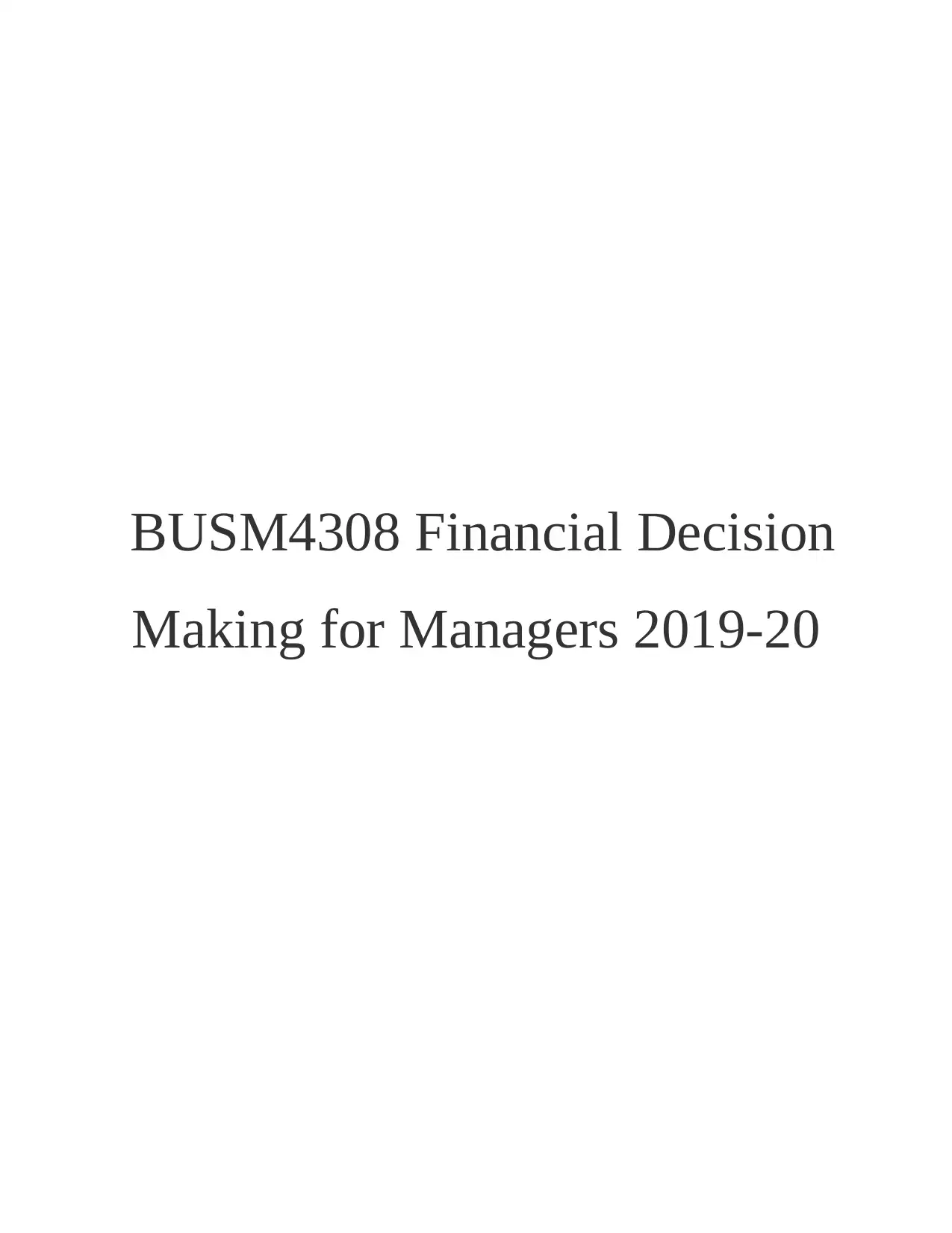
BUSM4308 Financial Decision
Making for Managers 2019-20
Making for Managers 2019-20
Paraphrase This Document
Need a fresh take? Get an instant paraphrase of this document with our AI Paraphraser
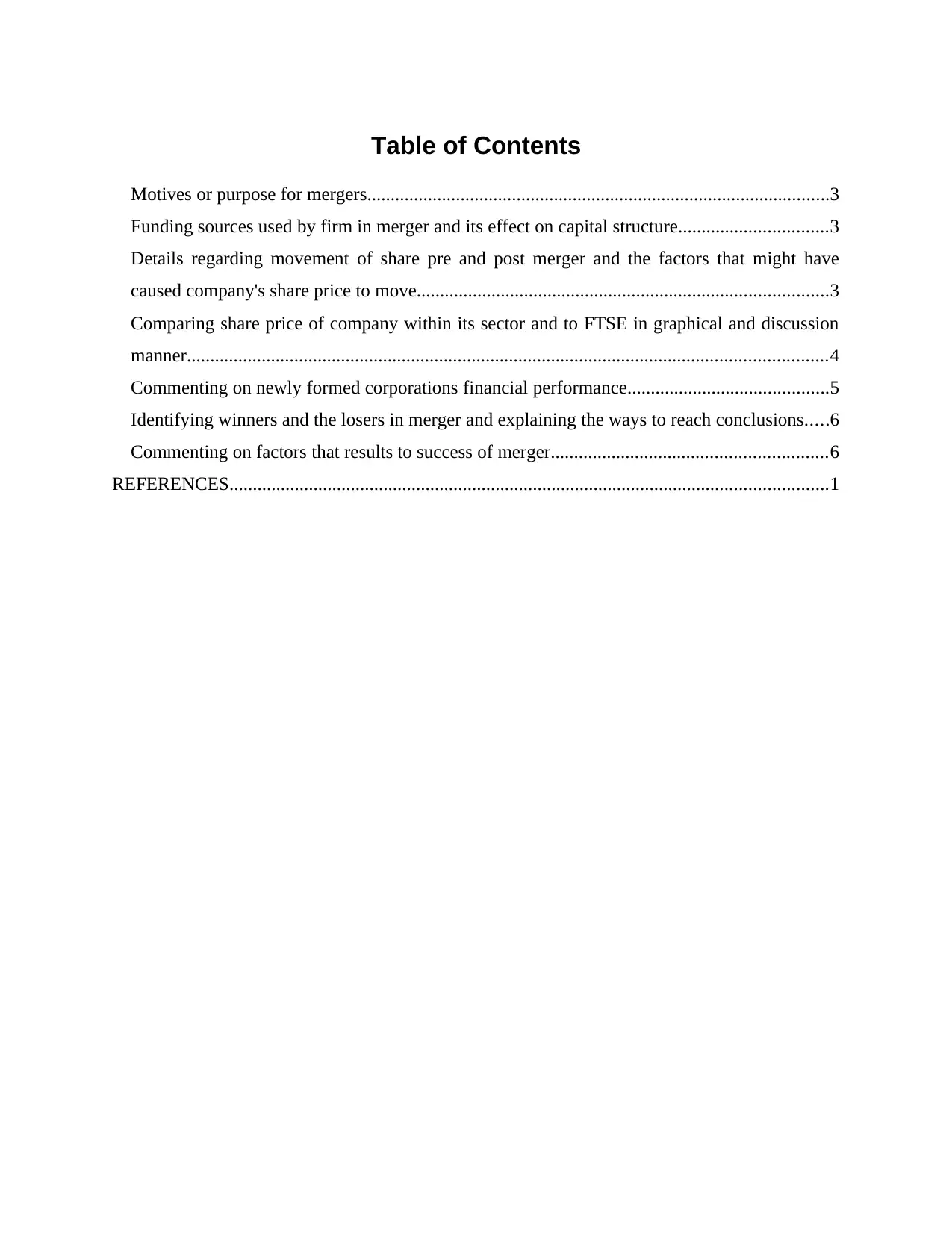
Table of Contents
Motives or purpose for mergers...................................................................................................3
Funding sources used by firm in merger and its effect on capital structure................................3
Details regarding movement of share pre and post merger and the factors that might have
caused company's share price to move........................................................................................3
Comparing share price of company within its sector and to FTSE in graphical and discussion
manner.........................................................................................................................................4
Commenting on newly formed corporations financial performance...........................................5
Identifying winners and the losers in merger and explaining the ways to reach conclusions.....6
Commenting on factors that results to success of merger...........................................................6
REFERENCES................................................................................................................................1
Motives or purpose for mergers...................................................................................................3
Funding sources used by firm in merger and its effect on capital structure................................3
Details regarding movement of share pre and post merger and the factors that might have
caused company's share price to move........................................................................................3
Comparing share price of company within its sector and to FTSE in graphical and discussion
manner.........................................................................................................................................4
Commenting on newly formed corporations financial performance...........................................5
Identifying winners and the losers in merger and explaining the ways to reach conclusions.....6
Commenting on factors that results to success of merger...........................................................6
REFERENCES................................................................................................................................1
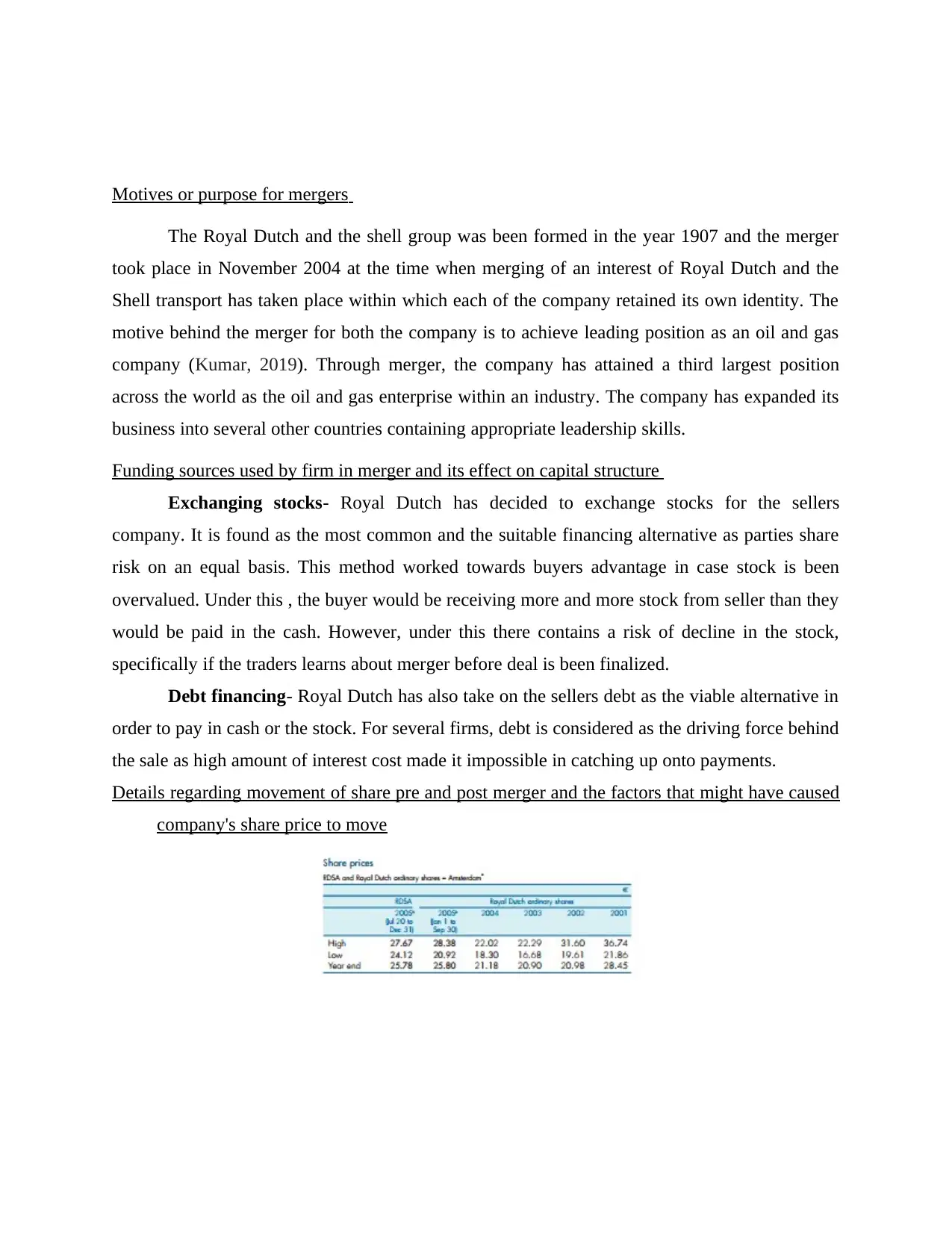
Motives or purpose for mergers
The Royal Dutch and the shell group was been formed in the year 1907 and the merger
took place in November 2004 at the time when merging of an interest of Royal Dutch and the
Shell transport has taken place within which each of the company retained its own identity. The
motive behind the merger for both the company is to achieve leading position as an oil and gas
company (Kumar, 2019). Through merger, the company has attained a third largest position
across the world as the oil and gas enterprise within an industry. The company has expanded its
business into several other countries containing appropriate leadership skills.
Funding sources used by firm in merger and its effect on capital structure
Exchanging stocks- Royal Dutch has decided to exchange stocks for the sellers
company. It is found as the most common and the suitable financing alternative as parties share
risk on an equal basis. This method worked towards buyers advantage in case stock is been
overvalued. Under this , the buyer would be receiving more and more stock from seller than they
would be paid in the cash. However, under this there contains a risk of decline in the stock,
specifically if the traders learns about merger before deal is been finalized.
Debt financing- Royal Dutch has also take on the sellers debt as the viable alternative in
order to pay in cash or the stock. For several firms, debt is considered as the driving force behind
the sale as high amount of interest cost made it impossible in catching up onto payments.
Details regarding movement of share pre and post merger and the factors that might have caused
company's share price to move
The Royal Dutch and the shell group was been formed in the year 1907 and the merger
took place in November 2004 at the time when merging of an interest of Royal Dutch and the
Shell transport has taken place within which each of the company retained its own identity. The
motive behind the merger for both the company is to achieve leading position as an oil and gas
company (Kumar, 2019). Through merger, the company has attained a third largest position
across the world as the oil and gas enterprise within an industry. The company has expanded its
business into several other countries containing appropriate leadership skills.
Funding sources used by firm in merger and its effect on capital structure
Exchanging stocks- Royal Dutch has decided to exchange stocks for the sellers
company. It is found as the most common and the suitable financing alternative as parties share
risk on an equal basis. This method worked towards buyers advantage in case stock is been
overvalued. Under this , the buyer would be receiving more and more stock from seller than they
would be paid in the cash. However, under this there contains a risk of decline in the stock,
specifically if the traders learns about merger before deal is been finalized.
Debt financing- Royal Dutch has also take on the sellers debt as the viable alternative in
order to pay in cash or the stock. For several firms, debt is considered as the driving force behind
the sale as high amount of interest cost made it impossible in catching up onto payments.
Details regarding movement of share pre and post merger and the factors that might have caused
company's share price to move
⊘ This is a preview!⊘
Do you want full access?
Subscribe today to unlock all pages.

Trusted by 1+ million students worldwide
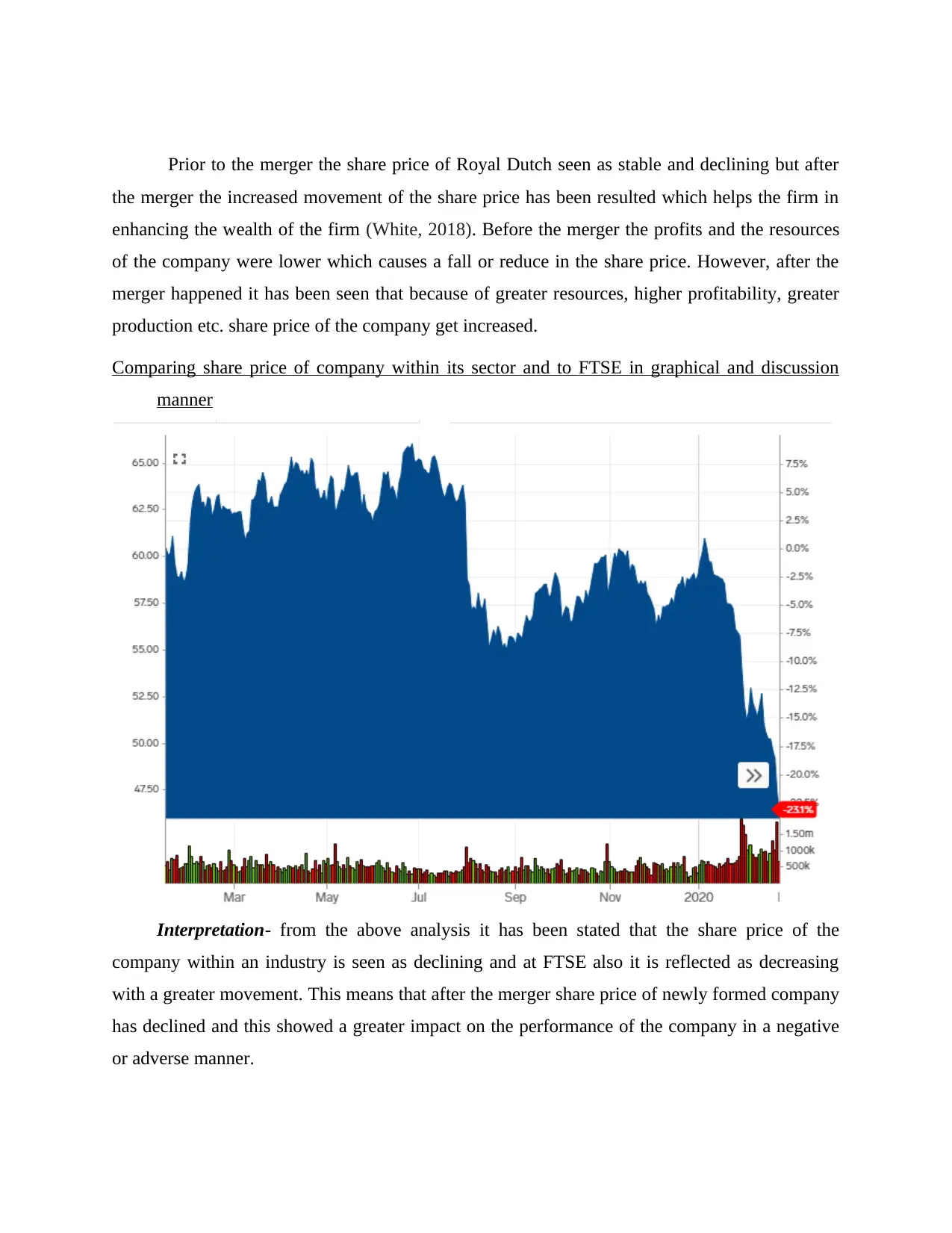
Prior to the merger the share price of Royal Dutch seen as stable and declining but after
the merger the increased movement of the share price has been resulted which helps the firm in
enhancing the wealth of the firm (White, 2018). Before the merger the profits and the resources
of the company were lower which causes a fall or reduce in the share price. However, after the
merger happened it has been seen that because of greater resources, higher profitability, greater
production etc. share price of the company get increased.
Comparing share price of company within its sector and to FTSE in graphical and discussion
manner
Interpretation- from the above analysis it has been stated that the share price of the
company within an industry is seen as declining and at FTSE also it is reflected as decreasing
with a greater movement. This means that after the merger share price of newly formed company
has declined and this showed a greater impact on the performance of the company in a negative
or adverse manner.
the merger the increased movement of the share price has been resulted which helps the firm in
enhancing the wealth of the firm (White, 2018). Before the merger the profits and the resources
of the company were lower which causes a fall or reduce in the share price. However, after the
merger happened it has been seen that because of greater resources, higher profitability, greater
production etc. share price of the company get increased.
Comparing share price of company within its sector and to FTSE in graphical and discussion
manner
Interpretation- from the above analysis it has been stated that the share price of the
company within an industry is seen as declining and at FTSE also it is reflected as decreasing
with a greater movement. This means that after the merger share price of newly formed company
has declined and this showed a greater impact on the performance of the company in a negative
or adverse manner.
Paraphrase This Document
Need a fresh take? Get an instant paraphrase of this document with our AI Paraphraser
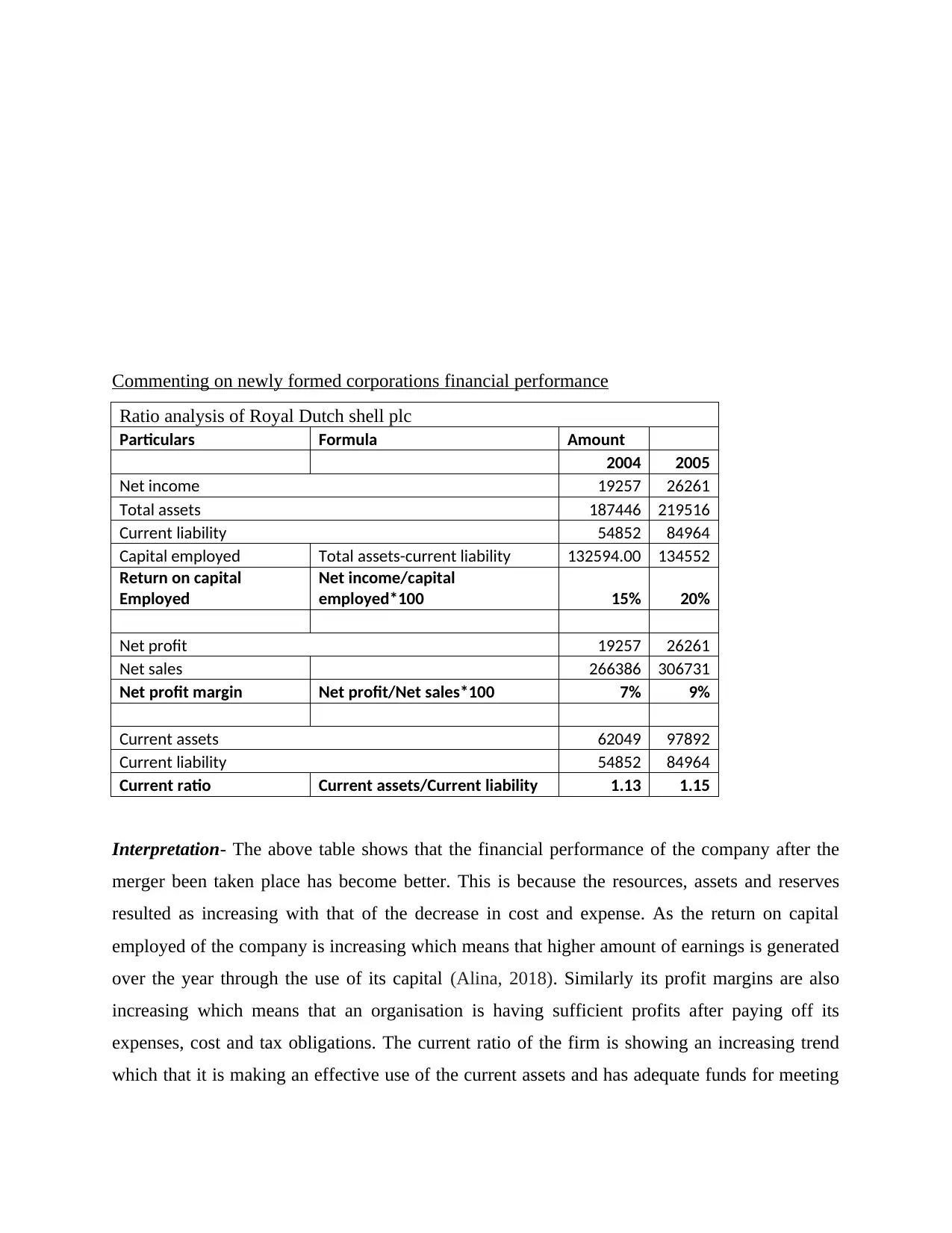
Commenting on newly formed corporations financial performance
Ratio analysis of Royal Dutch shell plc
Particulars Formula Amount
2004 2005
Net income 19257 26261
Total assets 187446 219516
Current liability 54852 84964
Capital employed Total assets-current liability 132594.00 134552
Return on capital
Employed
Net income/capital
employed*100 15% 20%
Net profit 19257 26261
Net sales 266386 306731
Net profit margin Net profit/Net sales*100 7% 9%
Current assets 62049 97892
Current liability 54852 84964
Current ratio Current assets/Current liability 1.13 1.15
Interpretation- The above table shows that the financial performance of the company after the
merger been taken place has become better. This is because the resources, assets and reserves
resulted as increasing with that of the decrease in cost and expense. As the return on capital
employed of the company is increasing which means that higher amount of earnings is generated
over the year through the use of its capital (Alina, 2018). Similarly its profit margins are also
increasing which means that an organisation is having sufficient profits after paying off its
expenses, cost and tax obligations. The current ratio of the firm is showing an increasing trend
which that it is making an effective use of the current assets and has adequate funds for meeting
Ratio analysis of Royal Dutch shell plc
Particulars Formula Amount
2004 2005
Net income 19257 26261
Total assets 187446 219516
Current liability 54852 84964
Capital employed Total assets-current liability 132594.00 134552
Return on capital
Employed
Net income/capital
employed*100 15% 20%
Net profit 19257 26261
Net sales 266386 306731
Net profit margin Net profit/Net sales*100 7% 9%
Current assets 62049 97892
Current liability 54852 84964
Current ratio Current assets/Current liability 1.13 1.15
Interpretation- The above table shows that the financial performance of the company after the
merger been taken place has become better. This is because the resources, assets and reserves
resulted as increasing with that of the decrease in cost and expense. As the return on capital
employed of the company is increasing which means that higher amount of earnings is generated
over the year through the use of its capital (Alina, 2018). Similarly its profit margins are also
increasing which means that an organisation is having sufficient profits after paying off its
expenses, cost and tax obligations. The current ratio of the firm is showing an increasing trend
which that it is making an effective use of the current assets and has adequate funds for meeting
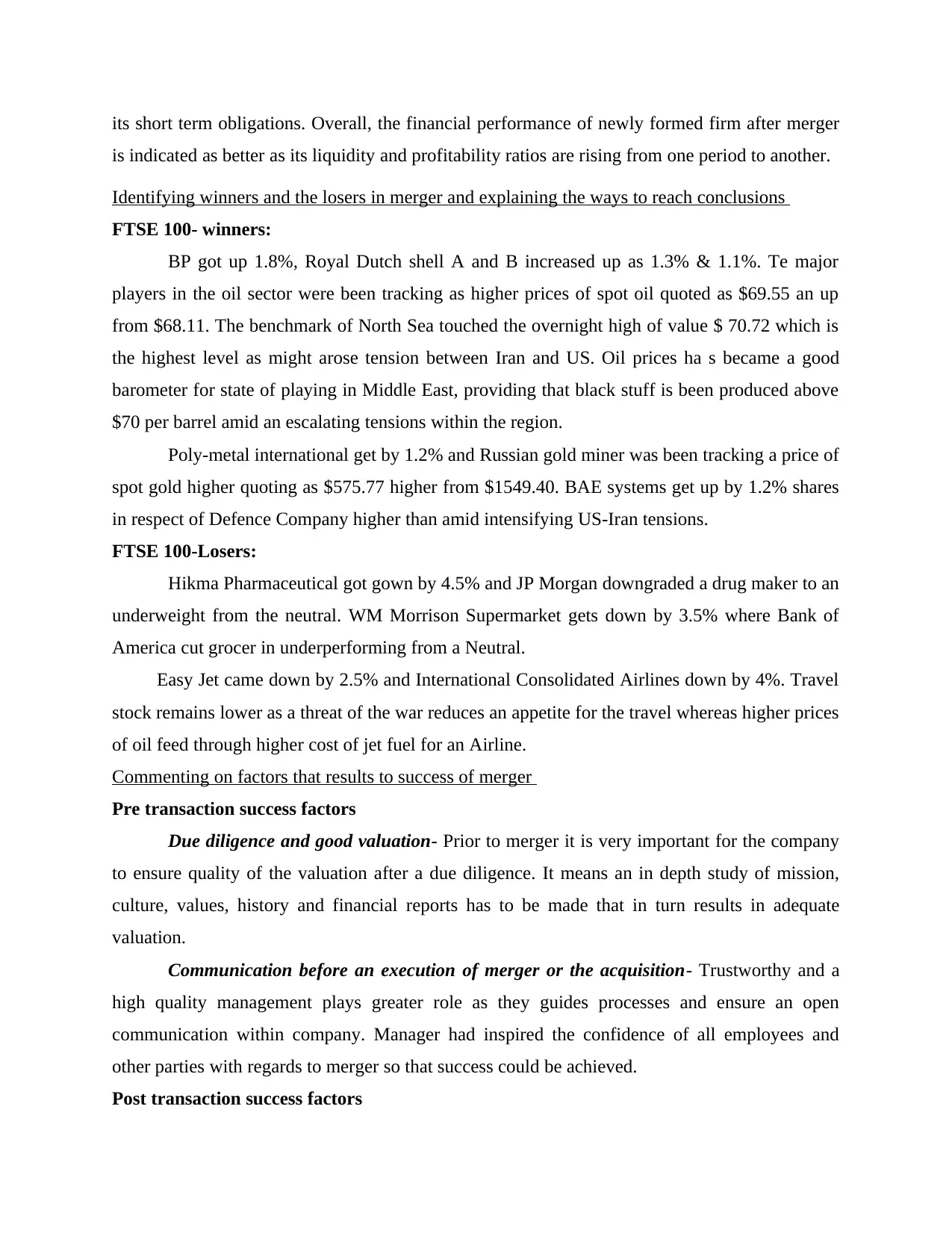
its short term obligations. Overall, the financial performance of newly formed firm after merger
is indicated as better as its liquidity and profitability ratios are rising from one period to another.
Identifying winners and the losers in merger and explaining the ways to reach conclusions
FTSE 100- winners:
BP got up 1.8%, Royal Dutch shell A and B increased up as 1.3% & 1.1%. Te major
players in the oil sector were been tracking as higher prices of spot oil quoted as $69.55 an up
from $68.11. The benchmark of North Sea touched the overnight high of value $ 70.72 which is
the highest level as might arose tension between Iran and US. Oil prices ha s became a good
barometer for state of playing in Middle East, providing that black stuff is been produced above
$70 per barrel amid an escalating tensions within the region.
Poly-metal international get by 1.2% and Russian gold miner was been tracking a price of
spot gold higher quoting as $575.77 higher from $1549.40. BAE systems get up by 1.2% shares
in respect of Defence Company higher than amid intensifying US-Iran tensions.
FTSE 100-Losers:
Hikma Pharmaceutical got gown by 4.5% and JP Morgan downgraded a drug maker to an
underweight from the neutral. WM Morrison Supermarket gets down by 3.5% where Bank of
America cut grocer in underperforming from a Neutral.
Easy Jet came down by 2.5% and International Consolidated Airlines down by 4%. Travel
stock remains lower as a threat of the war reduces an appetite for the travel whereas higher prices
of oil feed through higher cost of jet fuel for an Airline.
Commenting on factors that results to success of merger
Pre transaction success factors
Due diligence and good valuation- Prior to merger it is very important for the company
to ensure quality of the valuation after a due diligence. It means an in depth study of mission,
culture, values, history and financial reports has to be made that in turn results in adequate
valuation.
Communication before an execution of merger or the acquisition- Trustworthy and a
high quality management plays greater role as they guides processes and ensure an open
communication within company. Manager had inspired the confidence of all employees and
other parties with regards to merger so that success could be achieved.
Post transaction success factors
is indicated as better as its liquidity and profitability ratios are rising from one period to another.
Identifying winners and the losers in merger and explaining the ways to reach conclusions
FTSE 100- winners:
BP got up 1.8%, Royal Dutch shell A and B increased up as 1.3% & 1.1%. Te major
players in the oil sector were been tracking as higher prices of spot oil quoted as $69.55 an up
from $68.11. The benchmark of North Sea touched the overnight high of value $ 70.72 which is
the highest level as might arose tension between Iran and US. Oil prices ha s became a good
barometer for state of playing in Middle East, providing that black stuff is been produced above
$70 per barrel amid an escalating tensions within the region.
Poly-metal international get by 1.2% and Russian gold miner was been tracking a price of
spot gold higher quoting as $575.77 higher from $1549.40. BAE systems get up by 1.2% shares
in respect of Defence Company higher than amid intensifying US-Iran tensions.
FTSE 100-Losers:
Hikma Pharmaceutical got gown by 4.5% and JP Morgan downgraded a drug maker to an
underweight from the neutral. WM Morrison Supermarket gets down by 3.5% where Bank of
America cut grocer in underperforming from a Neutral.
Easy Jet came down by 2.5% and International Consolidated Airlines down by 4%. Travel
stock remains lower as a threat of the war reduces an appetite for the travel whereas higher prices
of oil feed through higher cost of jet fuel for an Airline.
Commenting on factors that results to success of merger
Pre transaction success factors
Due diligence and good valuation- Prior to merger it is very important for the company
to ensure quality of the valuation after a due diligence. It means an in depth study of mission,
culture, values, history and financial reports has to be made that in turn results in adequate
valuation.
Communication before an execution of merger or the acquisition- Trustworthy and a
high quality management plays greater role as they guides processes and ensure an open
communication within company. Manager had inspired the confidence of all employees and
other parties with regards to merger so that success could be achieved.
Post transaction success factors
⊘ This is a preview!⊘
Do you want full access?
Subscribe today to unlock all pages.

Trusted by 1+ million students worldwide
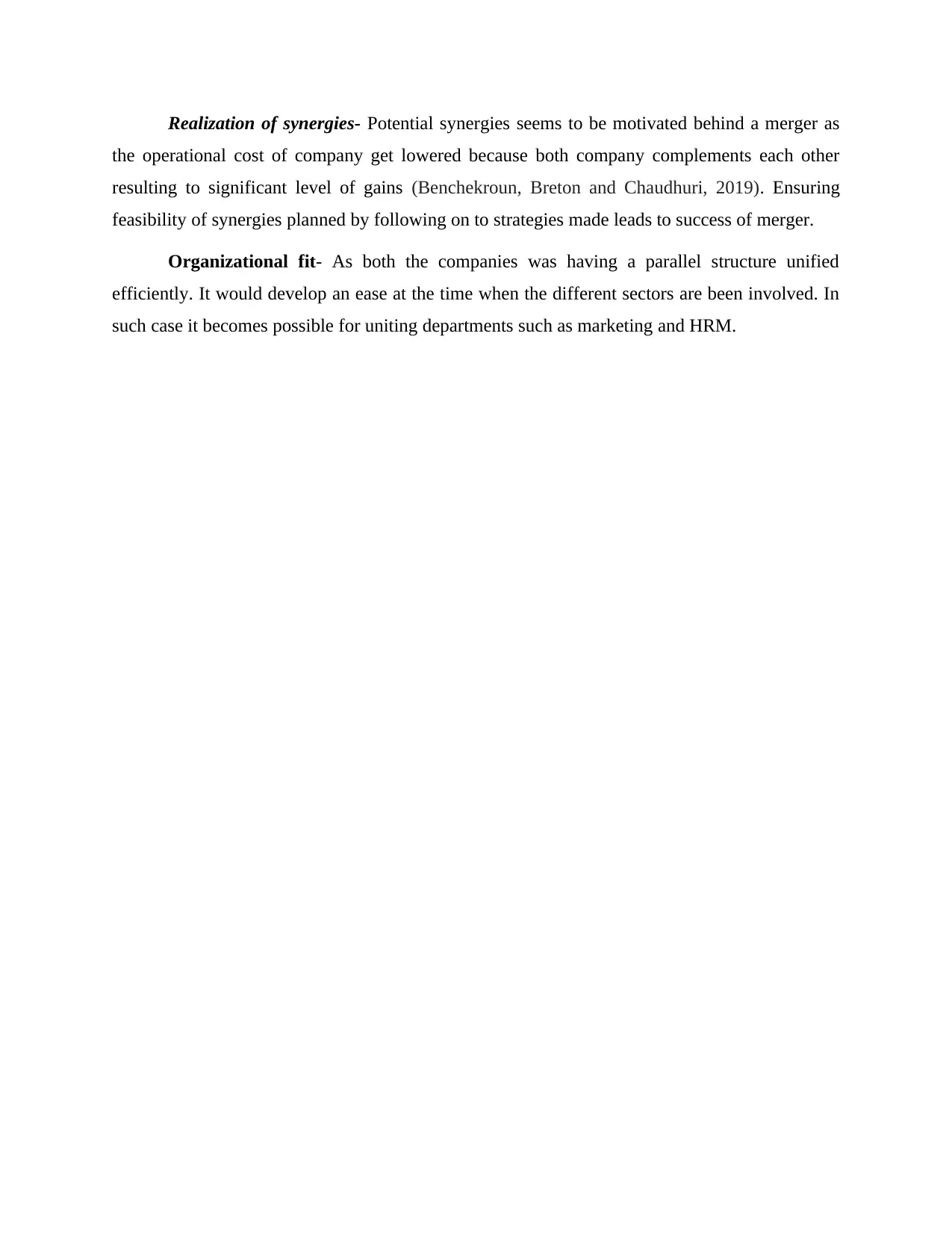
Realization of synergies- Potential synergies seems to be motivated behind a merger as
the operational cost of company get lowered because both company complements each other
resulting to significant level of gains (Benchekroun, Breton and Chaudhuri, 2019). Ensuring
feasibility of synergies planned by following on to strategies made leads to success of merger.
Organizational fit- As both the companies was having a parallel structure unified
efficiently. It would develop an ease at the time when the different sectors are been involved. In
such case it becomes possible for uniting departments such as marketing and HRM.
the operational cost of company get lowered because both company complements each other
resulting to significant level of gains (Benchekroun, Breton and Chaudhuri, 2019). Ensuring
feasibility of synergies planned by following on to strategies made leads to success of merger.
Organizational fit- As both the companies was having a parallel structure unified
efficiently. It would develop an ease at the time when the different sectors are been involved. In
such case it becomes possible for uniting departments such as marketing and HRM.
Paraphrase This Document
Need a fresh take? Get an instant paraphrase of this document with our AI Paraphraser
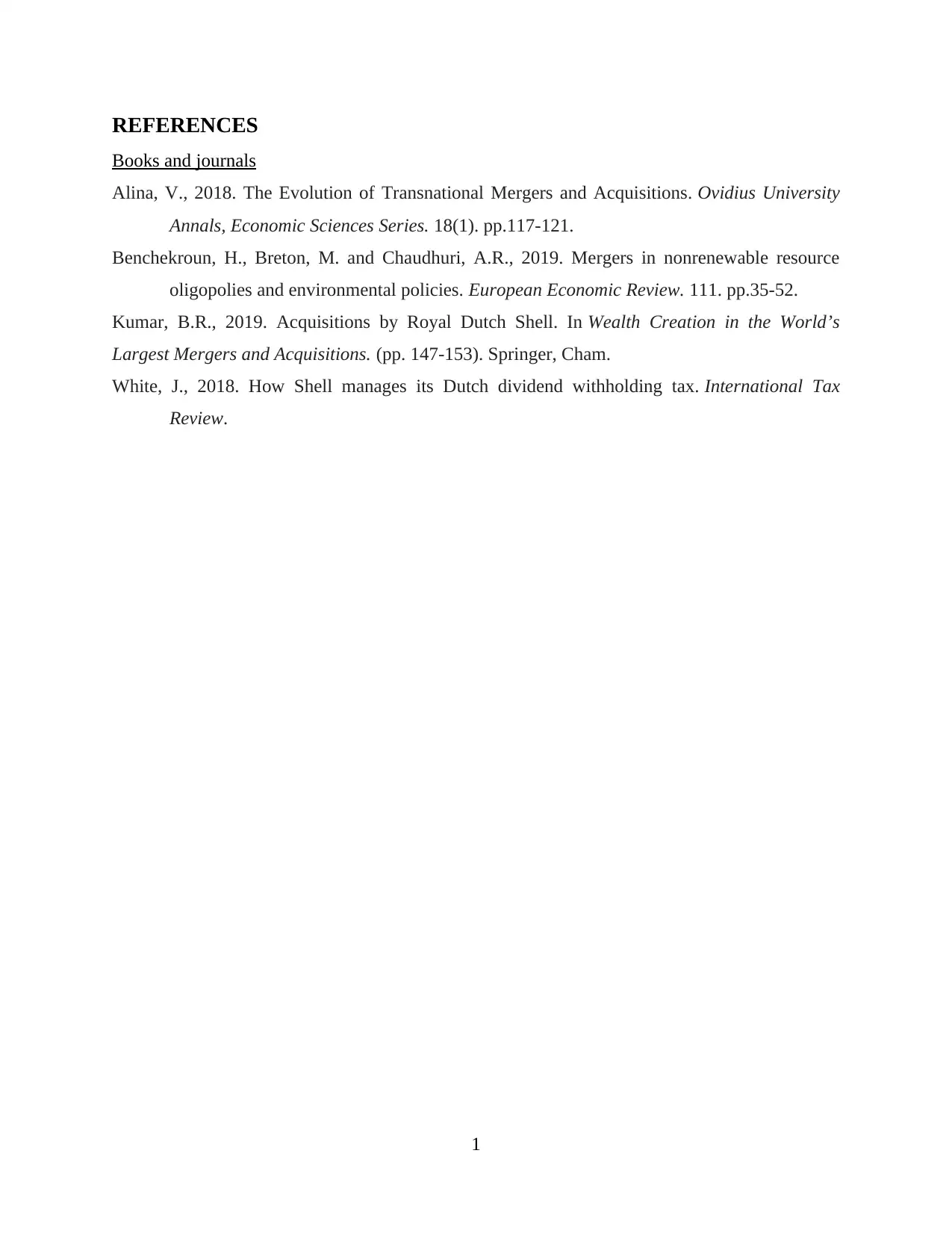
REFERENCES
Books and journals
Alina, V., 2018. The Evolution of Transnational Mergers and Acquisitions. Ovidius University
Annals, Economic Sciences Series. 18(1). pp.117-121.
Benchekroun, H., Breton, M. and Chaudhuri, A.R., 2019. Mergers in nonrenewable resource
oligopolies and environmental policies. European Economic Review. 111. pp.35-52.
Kumar, B.R., 2019. Acquisitions by Royal Dutch Shell. In Wealth Creation in the World’s
Largest Mergers and Acquisitions. (pp. 147-153). Springer, Cham.
White, J., 2018. How Shell manages its Dutch dividend withholding tax. International Tax
Review.
1
Books and journals
Alina, V., 2018. The Evolution of Transnational Mergers and Acquisitions. Ovidius University
Annals, Economic Sciences Series. 18(1). pp.117-121.
Benchekroun, H., Breton, M. and Chaudhuri, A.R., 2019. Mergers in nonrenewable resource
oligopolies and environmental policies. European Economic Review. 111. pp.35-52.
Kumar, B.R., 2019. Acquisitions by Royal Dutch Shell. In Wealth Creation in the World’s
Largest Mergers and Acquisitions. (pp. 147-153). Springer, Cham.
White, J., 2018. How Shell manages its Dutch dividend withholding tax. International Tax
Review.
1
1 out of 8
Related Documents
Your All-in-One AI-Powered Toolkit for Academic Success.
+13062052269
info@desklib.com
Available 24*7 on WhatsApp / Email
![[object Object]](/_next/static/media/star-bottom.7253800d.svg)
Unlock your academic potential
Copyright © 2020–2025 A2Z Services. All Rights Reserved. Developed and managed by ZUCOL.





